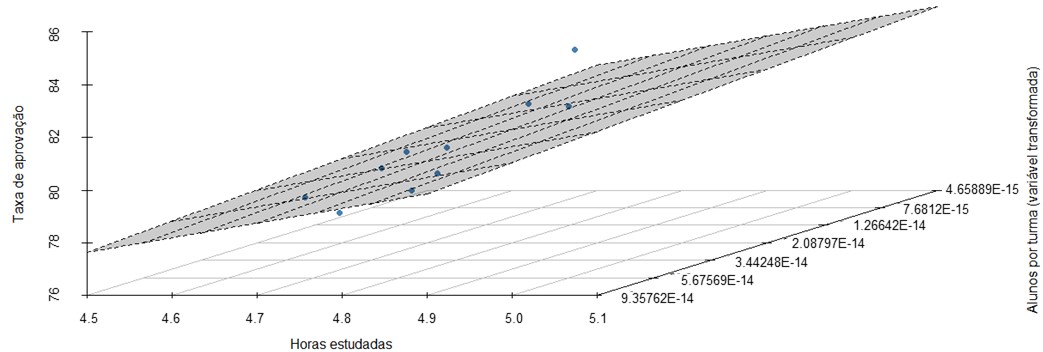Application of linear regression analysis in school performance of public high schools in Brazil
Keywords:
Educational Indicators, Regression Analysis, R SoftwareAbstract
From 2010 to 2019, according to data released by INEP, there was a reduction in the number of students that make up public High School classes in Brazil and, at the same time, there was a slight increase in the number of daily classes studied. It can also be noted that the pass rate, in the same period, went from 76% to 85%. Given this information, the following questions arise: Does the number of students in the classroom influence learning? Or, will increasing classroom hours result in better learning? Or, even more emphatic, will reducing the number of students in the classroom and increasing the study hours will the result be satisfactory to the point of raising the pass rate? Such questions were analyzed and answered through regression analysis models using the statistical R software. The results obtained by such models state that reducing the number of students in the classroom and/or increasing the study hours will have as an answer an increase in the pass rate, showing that the variables related to the initial questions influence the learning of public High School students in Brazil.
Keywords: Educational Indicators; Regression Analysis; R Software.
References
ALLAMAN, Ivan Bezerra. Transformação de dados. Ilhéus: Universidade Estadual de Santa Cruz, 2019.
BREUSCH, Trevor Stanley; PAGAN, Adrian Rodney. A simple test for heteroscedasticity and random coefcient variation, Econometrica, Biometrika, vol. 47, p.1287-1294, 1979.
BUSSAB, Wilton de Oliveira; MORETTIN, Pedro Alberto. Estatística Básica. 6. ed. São Paulo: Saraiva, 2010.
DURBIN, James; WATSON, Geoffrey Stuart. Test for Serial Correlation in Least Squares Regression, Biometrika, 37, p. 409-428, 1950.
INSTITUTO NACIONAL DE ESTUDOS E PESQUISAS EDUCACIONAIS ANÍSIO TEIXEIRA (INEP). Indicadores Educacionais, 2010-2019. Brasília, 02 Fevereiro 2020. Disponível em: $<$https://www.gov.br/inep/pt-br/acesso-a-informacao/dados-abertos/indicadores-educacionais/complexidade-de-gestao-da-escola$>$
LEWIS-BECK, Michael Steven. Applied Regression: an introduction. Series Quantitative Applications in the Social Sciences. [S.l.]: SAGE University Paper, 1980.
R CORE TEAM. R: A language and environment for statistical computing. R Foundation for Statistical Computing, Vienna, Austria. 2020. URL https://www.R-project.org/.
RODRIGUÊS, Sandra Cristina Antunes. Modelo de Regressão Linear e suas Aplicações. Universidade da Beira Interior. Covilhã. 2012.
SHAPIRO, Samuel Sanford; WILK, Martin Breadbury. An analysis of variance test for normality (complete samples), Biometrika, Vol. 52, p.591-611, 1965.

Downloads
Published
How to Cite
Issue
Section
License
Proposta de Política para Periódicos de Acesso Livre
Autores que publicam nesta revista concordam com os seguintes termos:
- Autores mantém os direitos autorais e concedem à revista o direito de primeira publicação, com o trabalho simultaneamente licenciado sob a Licença Creative Commons Attribution que permite o compartilhamento do trabalho com reconhecimento da autoria e publicação inicial nesta revista.
- Autores têm autorização para assumir contratos adicionais separadamente, para distribuição não-exclusiva da versão do trabalho publicada nesta revista (ex.: publicar em repositório institucional ou como capítulo de livro), com reconhecimento de autoria e publicação inicial nesta revista.
- Autores têm permissão e são estimulados a publicar e distribuir seu trabalho online (ex.: em repositórios institucionais ou na sua página pessoal) a qualquer ponto antes ou durante o processo editorial, já que isso pode gerar alterações produtivas, bem como aumentar o impacto e a citação do trabalho publicado (Veja O Efeito do Acesso Livre).
